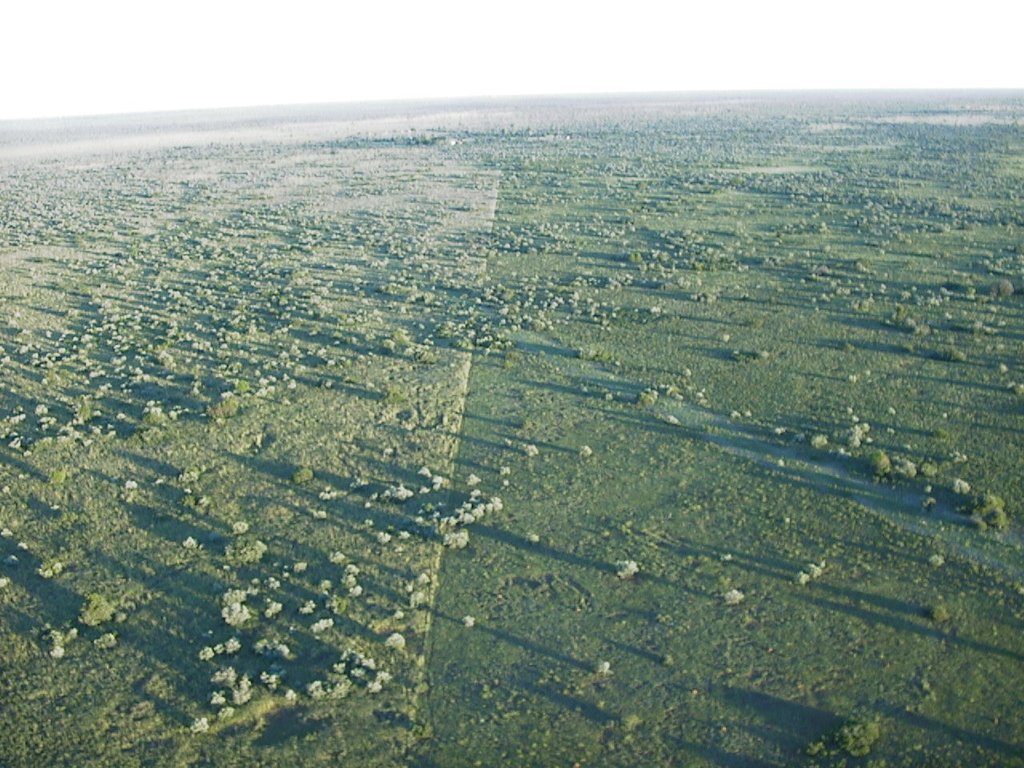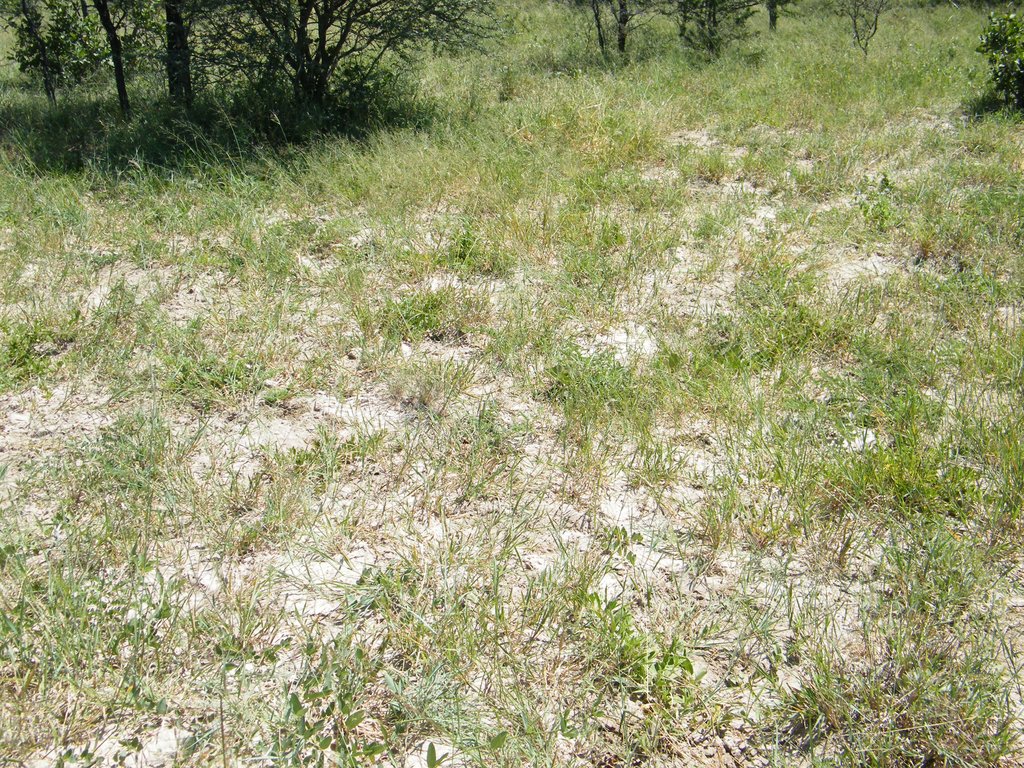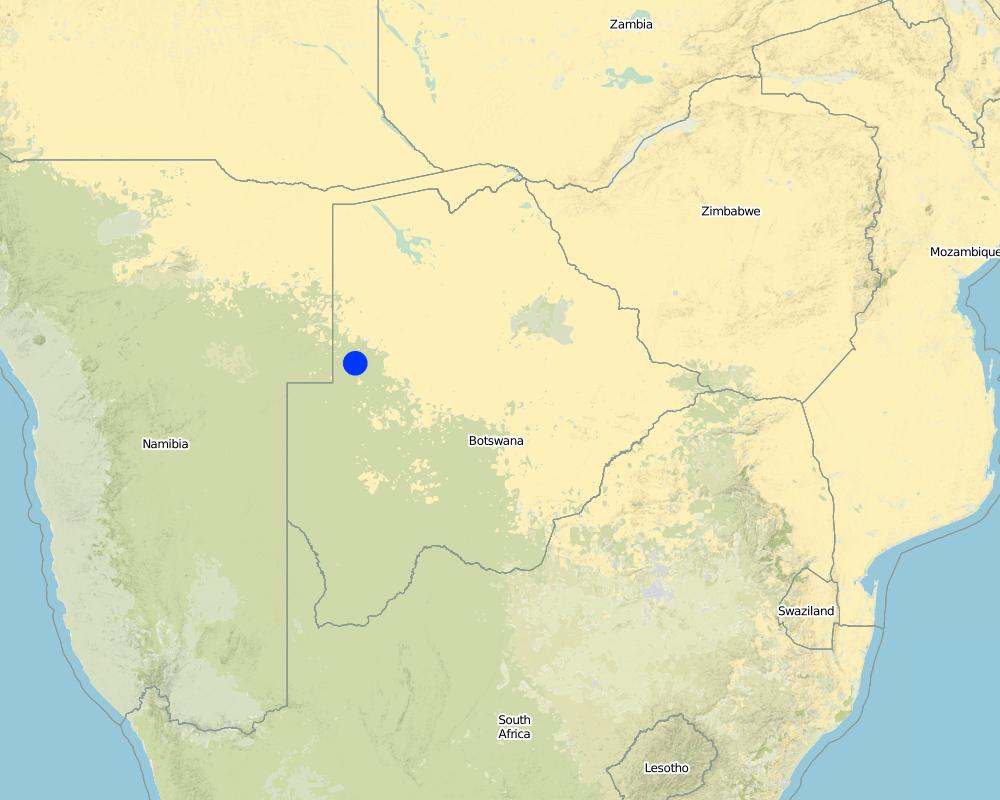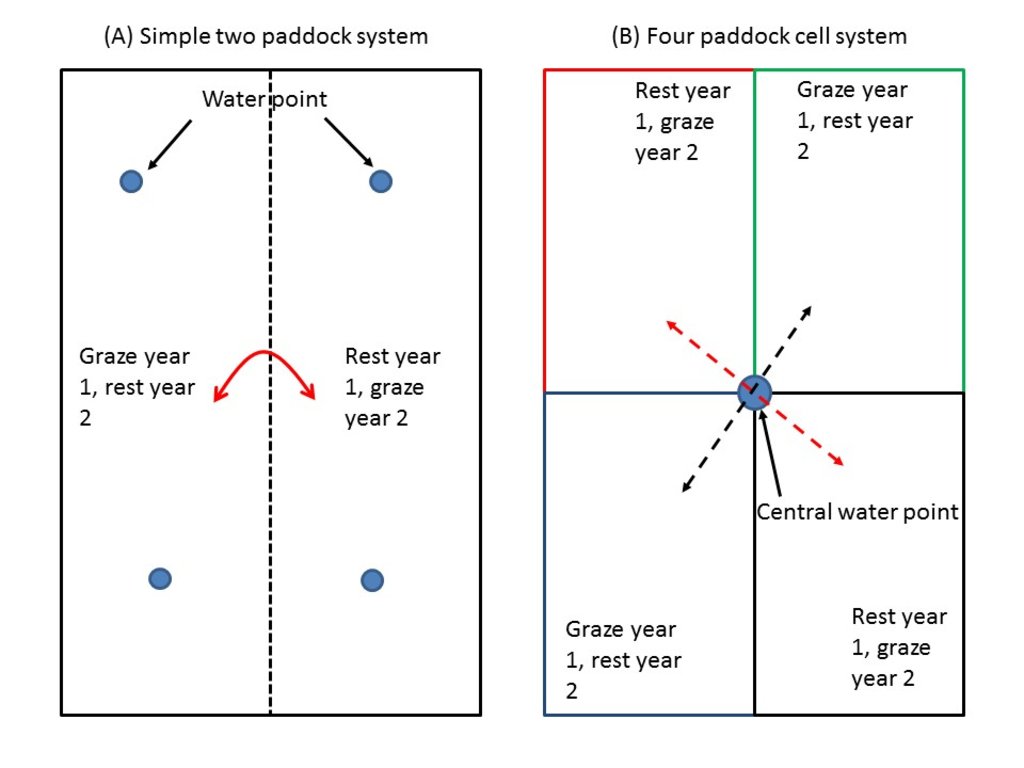Split Ranch Grazing Strategy [Botswana]
- Creation:
- Update:
- Compiler: Richard Fynn
- Editor: –
- Reviewers: Rima Mekdaschi Studer, Simone Verzandvoort
Riaan Dames Grazing Strategy
technologies_3217 - Botswana
- Full summary as PDF
- Full summary as PDF for print
- Full summary in the browser
- Full summary (unformatted)
- Split Ranch Grazing Strategy: Aug. 10, 2018 (inactive)
- Split Ranch Grazing Strategy: Okt. 22, 2018 (inactive)
- Split Ranch Grazing Strategy: Maart 7, 2019 (inactive)
- Split Ranch Grazing Strategy: Mei 13, 2018 (inactive)
- Split Ranch Grazing Strategy: Mei 22, 2018 (inactive)
- Split Ranch Grazing Strategy: Mei 23, 2018 (inactive)
- Split Ranch Grazing Strategy: Feb. 26, 2018 (inactive)
- Split Ranch Grazing Strategy: Nov. 2, 2021 (public)
- Split Ranch Grazing Strategy: Mei 13, 2018 (inactive)
- Split Ranch Grazing Strategy: Jan. 19, 2018 (inactive)
View sections
Expand all Collapse all1. General information
1.2 Contact details of resource persons and institutions involved in the assessment and documentation of the Technology
Key resource person(s)
SLM specialist:
Name of the institution(s) which facilitated the documentation/ evaluation of the Technology (if relevant)
University of Botswana (University of Botswana) - Botswana1.3 Conditions regarding the use of data documented through WOCAT
When were the data compiled (in the field)?
2017
The compiler and key resource person(s) accept the conditions regarding the use of data documented through WOCAT:
Ja
1.4 Declaration on sustainability of the described Technology
Is the Technology described here problematic with regard to land degradation, so that it cannot be declared a sustainable land management technology?
Nee
2. Description of the SLM Technology
2.1 Short description of the Technology
Definition of the Technology:
Split Ranch Grazing involves grazing half the available area for a full year - concentrating livestock. The consequent grazing pressure maintains the grassland in an immature, high-quality state, while resting the other half, allowing optimal recovery from the previous full years grazing. The technology is simple, requiring less fencing than more complex systems, without compromising sustainability or ecological function. These concepts can also be used for management in pastoral-wildlife systems to create habitat heterogeneity (short and tall grassland).
2.2 Detailed description of the Technology
Description:
The Split Ranch Grazing Strategy (SRG) was developed by Riaan Dames in the North West province, South Africa. It is fundamentally different to popular rotational management systems and contains several conceptual advances. One key difference is that SRG provides a full-year uninterrupted recovery period for rangeland after grazing. This enables grasses to maximize nutrient recovery over the main pulses of nutrient mineralization in the early wet season, and to maximize root growth and associated nutrient storage over the late wet season and early dry season - when most root growth occurs. Optimal recovery periods should ideally, therefore, encompass the full wet season and the early dry season. This contrasts with rotational grazing where recovery and grazing periods are apportioned across these two periods, with resting periods often not occurring in key periods of nutrient uptake and root growth.
A major problem with having both grazing and recovery periods in the same season is that grassland is able to mature during recovery periods, greatly reducing forage quality and grass growth rates, thereby negatively impacting animal production. Another problem is that complex rotational grazing requires strategies investing much in a complex and expensive fencing infrastructure. The solution is a fundamentally different strategy where some paddocks are grazed the whole year to prevent grassland maturation and other paddocks are simultaneously rested to optimize recovery. In addition, paddocks should be as few, and as large as possible, to maximize livestock access to functional resource heterogeneity, thereby improving adaptive foraging options, while reducing costs of fencing (fencing can even be replaced by using physical boundaries (e.g. roads, rivers, etc.) and herding the livestock.
Livestock are maintained in the grazing paddocks until mid-dry season to ensure that grasses in the rested paddocks have completed root growth and ceased all other growth – thus fully rested and recovered. A full years rest allows maximum uptake and storage of nutrients in deep, strong root systems and crowns. Thus when these grasses are grazed in the next season they have not only efficient root uptake of moisture and nutrients from the soil but also can re-allocate nutrients stored in roots to leaf production after each grazing event, resulting in a productive supply of high-quality fresh leaf to livestock over the growing season.
Movement of livestock into the year-long rested paddocks halfway through the dry season ensures that they have a large reserve of forage. Concentration of livestock on half the available area (half the paddocks are rested and the other half grazed) ensures sufficient grazing pressure to maintain grassland in an immature, high-quality and rapidly-growing state for maximizing forage quality, leaf production and livestock production, further enhanced by greater adaptive foraging options in large paddocks. The technology was started in North West province South Africa, and is now being taken up in Botswana and Namibia. A model example is Tiisa Kalahari Ranch in the Ghanzi region of Botswana. The ranch has been partitioned into several four-paddock cells, each with their own cattle herd. Cattle graze two paddocks while the other two are rested for a full year. Cattle enter the rested paddocks, which have developed a large reserve of forage, in the mid dry season (July) once forage is depleted in the two grazed paddocks. This technology (SRG), used on the award-winning Danielskuil ranch in South Africa, has been employed at Tiisa for six years after being in a degraded state. Indications are that the rangeland has been steadily recovering with increases in abundance of high-quality grasses. Monitoring programs are being established to monitor the trends in cover of the various grass species over time.
2.3 Photos of the Technology
2.4 Videos of the Technology
Comments, short description:
Tour of several ranches using the split ranch grazing strategy: April 2016, North West Province, South Africa. The video was compiled by Ibo Zimmerman.
See https://www.youtube.com/watch?v=9lOAr1RT69M
Date:
2016
Location:
North West Province, South Africa
Name of videographer:
Ibo Zimmerman
2.5 Country/ region/ locations where the Technology has been applied and which are covered by this assessment
Country:
Botswana
Region/ State/ Province:
Ghanzi Province
Further specification of location:
Ghanzi, Tiisa Kalahari Ranch
Comments:
Longitude: -21.60026 (decimal degrees)
Latitude: 21.48969
Map
×2.6 Date of implementation
If precise year is not known, indicate approximate date:
- less than 10 years ago (recently)
2.7 Introduction of the Technology
- Through interaction with Riaan Dames
3. Classification of the SLM Technology
3.1 Main purpose(s) of the Technology
- improve production
- reduce, prevent, restore land degradation
- conserve ecosystem
- protect a watershed/ downstream areas – in combination with other Technologies
- preserve/ improve biodiversity
- create beneficial economic impact
3.2 Current land use type(s) where the Technology is applied

Grazing land
Extensive grazing land:
- Semi-nomadism/ pastoralism
- Ranching
Main animal species and products:
The technology can be used for ranching cattle, sheep or goats or using planned herding of these livestock types according to the key concepts outlined in the technology. Products would be meat, wool and to a lesser degree, milk.
3.3 Further information about land use
Water supply for the land on which the Technology is applied:
- rainfed
Comments:
Mainly rainfed but some irrigation of improved pasture for dry season forage would be fine
Number of growing seasons per year:
- 1
Specify:
Mostly one growing season but can be in a bimodal rainfall region
Livestock density (if relevant):
At conservative stocking rates to ensure that animals are able to remain in the planned grazed paddocks until the mid dry season. Stocking rate will depend upon the local rainfall and soils and associated grass production. 10-15ha/ LSU in semi-arid regions
3.4 SLM group to which the Technology belongs
- pastoralism and grazing land management
3.5 Spread of the Technology
Specify the spread of the Technology:
- evenly spread over an area
If the Technology is evenly spread over an area, indicate approximate area covered:
- 10-100 km2
Comments:
Not restricted to any size of land - any size ranch
3.6 SLM measures comprising the Technology

management measures
- M2: Change of management/ intensity level
- M4: Major change in timing of activities
Comments:
It involves grazing management. Managing stocking rate and the time spent grazing or resting a paddock
3.7 Main types of land degradation addressed by the Technology

soil erosion by water
- Wt: loss of topsoil/ surface erosion
- Wg: gully erosion/ gullying

soil erosion by wind
- Et: loss of topsoil

biological degradation
- Bc: reduction of vegetation cover
- Bq: quantity/ biomass decline
- Bs: quality and species composition/ diversity decline
Comments:
Preventing undesirable changes in grass cover and composition
3.8 Prevention, reduction, or restoration of land degradation
Specify the goal of the Technology with regard to land degradation:
- prevent land degradation
- restore/ rehabilitate severely degraded land
Comments:
The key goals are to improve grass composition and cover, reduce soil erosion and to improve livestock production
4. Technical specifications, implementation activities, inputs, and costs
4.1 Technical drawing of the Technology
4.2 Technical specifications/ explanations of technical drawing
SRG can be implemented as simply as dividing the ranch into two paddocks with livestock spending alternate years in each paddock (A) or the ranch can be divided up into several cells according to needs, such as having to separate breeding herds, bull herds and weaners (B). In scenario A it is important to ensure good water distribution in each paddock to ensure access to the whole paddock. This simple scenario (A) is ideal for rural development schemes owing to minimal infrastructure costs and is easy for rural communities to implement. Another advantage is that it gives livestock much greater adaptive foraging options. In scenario B a central water point provides a convenient way of changing the livestock between paddocks. The gates can be left open between diagonal paddocks to allow livestock freedom of access to either of the diagonal paddocks or they can be actively moved between diagonals during the grazing year according to the rancher’s decisions. If paddocks are extremely large then other water points should be provided across the paddocks to allow livestock even access to all parts of the paddock.
4.3 General information regarding the calculation of inputs and costs
Specify how costs and inputs were calculated:
- per Technology unit
other/ national currency (specify):
Pulla (BWP)
4.4 Establishment activities
| Activity | Type of measure | Timing | |
|---|---|---|---|
| 1. | Building fences | Structural | At the start |
| 2. | Digging Boreholes | Structural | At the start |
| 3. | Setting up water reticulation and drinking troughs | Structural | At the start |
| 4. | Buildling animal loading facilities | Structural | At the start |
| 5. | Handling of livestock | Management | throughout the year |
4.5 Costs and inputs needed for establishment
| Specify input | Unit | Quantity | Costs per Unit | Total costs per input | % of costs borne by land users | |
|---|---|---|---|---|---|---|
| Labour | Labourers | paddocks | 7.0 | 24000.0 | 168000.0 | 100.0 |
| Equipment | Water trough, fitting and piping | paddocks | 7.0 | 8000.0 | 56000.0 | 100.0 |
| Equipment | Solar pump | paddocks | 7.0 | 20000.0 | 140000.0 | 100.0 |
| Equipment | Fencing | paddocks | 7.0 | 80000.0 | 560000.0 | 100.0 |
| Equipment | Boreholes | paddocks | 7.0 | 20000.0 | 140000.0 | 100.0 |
| Other | Loading facilities | 1.0 | 30000.0 | 30000.0 | 100.0 | |
| Total costs for establishment of the Technology | 1094000.0 | |||||
4.6 Maintenance/ recurrent activities
| Activity | Type of measure | Timing/ frequency | |
|---|---|---|---|
| 1. | Maintenance of fences | Structural | Throughout |
| 2. | Maintenance of water pipes and pumps | Structural | Throughout |
| 3. | Maintenance of vehicles | Structural | Throughout |
| 4. | Animal handling | Management | Throughout |
| 5. | Supplementary feeding (if needed) | Management | dry season |
4.7 Costs and inputs needed for maintenance/ recurrent activities (per year)
| Specify input | Unit | Quantity | Costs per Unit | Total costs per input | % of costs borne by land users | |
|---|---|---|---|---|---|---|
| Plant material | supplementary feed | bale | 1.0 | 9.0 | 9.0 | 100.0 |
| Total costs for maintenance of the Technology | 9.0 | |||||
Comments:
Bales of hay cost 7-9 USD in Botswana depending on availability
4.8 Most important factors affecting the costs
Describe the most determinate factors affecting the costs:
Fencing and infrastructure have been shown to be major factors increasing establishment and maintenance costs and reducing profits. Thus SRG aims to reduce these costs by having fewer larger paddocks, which also has benefits for the animals. Another major cost is that of supplementary feeding, especially if forage is depleted during the dry season. This technology aims to ensure that a reserve of forage is created for the dry season, to overcome this. It also aims to improve the quality of forage during the wet season so that supplementary feeding is not needed for fertility improvement.
5. Natural and human environment
5.1 Climate
Annual rainfall
- < 250 mm
- 251-500 mm
- 501-750 mm
- 751-1,000 mm
- 1,001-1,500 mm
- 1,501-2,000 mm
- 2,001-3,000 mm
- 3,001-4,000 mm
- > 4,000 mm
Specify average annual rainfall (if known), in mm:
432.00
Specifications/ comments on rainfall:
While Split Ranch Grazing is mainly applied in semi-arid climates with a long dry season, the relevance of SRG is likely to increase with increasing rainfall because of the greater decline in forage quality as grassland matures in higher rainfall areas; hence the greater need to concentrate grazing pressure to prevent grassland maturation.
Indicate the name of the reference meteorological station considered:
Department of Meteorological Services, Botswana
Agro-climatic zone
- semi-arid
Can be operated in semi-arid, sub-humid or humid environments.
5.2 Topography
Slopes on average:
- flat (0-2%)
- gentle (3-5%)
- moderate (6-10%)
- rolling (11-15%)
- hilly (16-30%)
- steep (31-60%)
- very steep (>60%)
Landforms:
- plateau/plains
- ridges
- mountain slopes
- hill slopes
- footslopes
- valley floors
Altitudinal zone:
- 0-100 m a.s.l.
- 101-500 m a.s.l.
- 501-1,000 m a.s.l.
- 1,001-1,500 m a.s.l.
- 1,501-2,000 m a.s.l.
- 2,001-2,500 m a.s.l.
- 2,501-3,000 m a.s.l.
- 3,001-4,000 m a.s.l.
- > 4,000 m a.s.l.
Indicate if the Technology is specifically applied in:
- not relevant
Comments and further specifications on topography:
Any situation is appropriate
5.3 Soils
Soil depth on average:
- very shallow (0-20 cm)
- shallow (21-50 cm)
- moderately deep (51-80 cm)
- deep (81-120 cm)
- very deep (> 120 cm)
Soil texture (topsoil):
- coarse/ light (sandy)
Soil texture (> 20 cm below surface):
- coarse/ light (sandy)
Topsoil organic matter:
- medium (1-3%)
If available, attach full soil description or specify the available information, e.g. soil type, soil PH/ acidity, Cation Exchange Capacity, nitrogen, salinity etc.
The ranch has deep Kalahari sands in some sections and shallow rocky soils on calcrete in other sections. Nevertheless the technology is appropriate for any soil type
5.4 Water availability and quality
Ground water table:
< 5 m
Availability of surface water:
good
Water quality (untreated):
good drinking water
Is water salinity a problem?
Nee
Is flooding of the area occurring?
Nee
5.5 Biodiversity
Species diversity:
- medium
Habitat diversity:
- medium
5.6 Characteristics of land users applying the Technology
Sedentary or nomadic:
- Sedentary
- Semi-nomadic
Market orientation of production system:
- commercial/ market
Off-farm income:
- less than 10% of all income
Relative level of wealth:
- average
Individuals or groups:
- individual/ household
Level of mechanization:
- mechanized/ motorized
Gender:
- men
Age of land users:
- middle-aged
Indicate other relevant characteristics of the land users:
The technology can be applied under commercial ranching situations using fenced paddocks to control the spatial and temporal distribution of livestock or it can be applied by semi-nomadic pastoralists using planned herding to control the spatial and temporal distribution of livestock.
5.7 Average area of land owned or leased by land users applying the Technology
- < 0.5 ha
- 0.5-1 ha
- 1-2 ha
- 2-5 ha
- 5-15 ha
- 15-50 ha
- 50-100 ha
- 100-500 ha
- 500-1,000 ha
- 1,000-10,000 ha
- > 10,000 ha
Is this considered small-, medium- or large-scale (referring to local context)?
- medium-scale
5.8 Land ownership, land use rights, and water use rights
Land ownership:
- individual, titled
Land use rights:
- individual
Water use rights:
- individual
5.9 Access to services and infrastructure
health:
- poor
- moderate
- good
education:
- poor
- moderate
- good
technical assistance:
- poor
- moderate
- good
employment (e.g. off-farm):
- poor
- moderate
- good
markets:
- poor
- moderate
- good
energy:
- poor
- moderate
- good
roads and transport:
- poor
- moderate
- good
drinking water and sanitation:
- poor
- moderate
- good
financial services:
- poor
- moderate
- good
6. Impacts and concluding statements
6.1 On-site impacts the Technology has shown
Socio-economic impacts
Production
fodder production
Comments/ specify:
For details see:
Fynn, R.W.S. Kirkman, K & Dames, R. (2017).
fodder quality
Comments/ specify:
Forage quality improved by keeping the grass in an immature state. For details see:
Fynn, R.W.S. Kirkman, K & Dames, R. (2017).
animal production
Comments/ specify:
Benefit from improved forage quality and larger spatial scales for adaptive foraging. For detail see:
Fynn, R.W.S. Kirkman, K & Dames, R. (2017).
Ecological impacts
Water cycle/ runoff
water quantity
Comments/ specify:
Better soil cover and protection
water quality
Comments/ specify:
Better soil cover and protection
surface runoff
Comments/ specify:
Better soil cover and protection
Biodiversity: vegetation, animals
Vegetation cover
biomass/ above ground C
habitat diversity
6.2 Off-site impacts the Technology has shown
reliable and stable stream flows in dry season
Comments/ specify:
Better grass cover should improve water capture and stream flow
downstream flooding
Comments/ specify:
Better grass cover should reduce runoff rates and downstream flooding
downstream siltation
Comments/ specify:
Better grass cover should reduce runoff and erosion rates thereby reducing downstream siltation
6.4 Cost-benefit analysis
How do the benefits compare with the establishment costs (from land users’ perspective)?
Short-term returns:
positive
Long-term returns:
positive
How do the benefits compare with the maintenance/ recurrent costs (from land users' perspective)?
Short-term returns:
positive
Long-term returns:
positive
Comments:
This technology aims to reduce infrastructure and maintenance costs by reducing the amount of fencing. It also aims to reduce reliance on supplementary feeding.
6.5 Adoption of the Technology
- 1-10%
If available, quantify (no. of households and/ or area covered):
In Ghanzi region of Botswana probably about five ranchers have adopted the technology
Of all those who have adopted the Technology, how many have did so spontaneously, i.e. without receiving any material incentives/ payments?
- 90-100%
Comments:
They have adopted the technology because of seeing the results of those using the technology and from farmers day talks
6.6 Adaptation
Has the Technology been modified recently to adapt to changing conditions?
Nee
6.7 Strengths/ advantages/ opportunities of the Technology
| Strengths/ advantages/ opportunities in the land user’s view |
|---|
|
Management complexity is reduced - fewer paddocks and less frequent movement between paddocks. |
| Establishment and maintenance costs are lower than complex rotational grazing systems owing to less fencing required. Livestock production increased relative to costs. |
| Need for supplementary feed and mineral licks reduced owing to livestock having greater adaptive foraging options. |
| Rangeland condition improved. |
| Rangeland condition improved - better grass cover and greater abundance of high-quality perennial grasses. |
| Strengths/ advantages/ opportunities in the compiler’s or other key resource person’s view |
|---|
|
Conceptually the most robust grazing management technology: Extremely long recovery periods promotes sustainability |
| Low establishment and maintenance costs relative to production. |
| Concentration of livestock on half the available area enables sufficient grazing pressure to prevent grassland maturation and loss of forage quality |
| Development of a large reserve of forage for the dry season through season long resting promotes stability and reduces needs for supplementary feeding (increased profits). |
| Very large paddocks combined with minimal forced movement of livestock promotes adaptive foraging options for livestock thereby reducing need for supplementary feeding and licks (increased profits). |
6.8 Weaknesses/ disadvantages/ risks of the Technology and ways of overcoming them
| Weaknesses/ disadvantages/ risks in the land user’s view | How can they be overcome? |
|---|---|
| Less intensive management increases predation events on livestock. | Herding of livestock. |
| Weaknesses/ disadvantages/ risks in the compiler’s or other key resource person’s view | How can they be overcome? |
|---|---|
|
Potential over/under use of certain habitat type. Less control of timing and intensity of grazing distribution could result in damage to sensitive habitat types. |
Monitoring by the rancher of impacts on vegetation and use of water point reticulation/ lick placement/herding to move animals to underutilized areas. |
7. References and links
7.1 Methods/ sources of information
- field visits, field surveys
Many trips to Tiisa ranch to conduct monitoring work
- interviews with land users
Have spoken to several land owners using the technology
- interviews with SLM specialists/ experts
Have had much interaction with Riaan Dames who developed the technology
7.2 References to available publications
Title, author, year, ISBN:
Optimal grazing management strategies: Evaluating key concepts Fynn, R.W.S., Kirkman, K.P. and Dames, R. 2017. African Journal of Range and Forage Science 34 (2): 87-98
Available from where? Costs?
Taylor and Francis Publishers
Title, author, year, ISBN:
Towards optimal rangeland management. Fynn, R.W.S. 2015. Farmers Weekly 18: 56-59
Available from where? Costs?
Farmers weekly magazine
7.3 Links to relevant information which is available online
Title/ description:
Grazing Strategy of Riaan Dames
URL:
https://www.youtube.com/watch?v=9lOAr1RT69M
Links and modules
Expand all Collapse allLinks
No links
Modules
No modules






